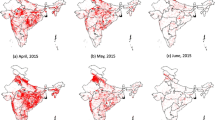Abstract
Biomass burning is a global phenomenon with agriculture residue burning having a sizeable share. Biomass burning is a major source of emission of green house gases (GHGs). Thus the space-based observations of global distribution of fire form a key component of climate change studies. This study is a step towards understanding the spatio-temporal occurrence of agricultural residues burning in Indo-Gangetic plains of India using fire products from space borne satellites. The 3 years daily active fire data of MODIS (Aqua/Terra) from August, 2006 to July, 2009 have been used in this study. The data analysis showed that out of total fire events, around 69% contribution comes from agricultural areas and remaining (31%) comes from non-agricultural areas. This is mainly due to the intensive cultivation in this belt. The characterisation analysis revealed that, 84% of agriculture residues burning is from Rice-Wheat system (RWS) alone and remaining 16% in other types of crop rotations. The fire incidents were very high in October–December (55%) compared to that in March–May (36%), further indicating that burning of rice residue is more prevalent than that of wheat.



Similar content being viewed by others
References
Arino, O. & Rosaz, J. M. (1999). World ATSR fire Atlas using ERS-2 ATSR-2 Data. Proceedings of the Joint Fire Science Conference, Boise, pp. 15–17.
Badrinath, K. V. S., Kiran Chand, T. R., & Krishna Prasad, V. (2006). Agriculture crop residue burning in the Indo-Gangetic Plains—a study using IRSP6 WiFS satellite data. Current Science, 91(8), 1085–1089.
Chander, J., Suseendra, B., Aggarwal, I. K., Lata, S., Meena, M. K., & Chhatwani, M. (2001), State-wise average size of operational holdings by major size groups, 1990–91, In: Agriculture Statistics at a Glance 2001, Agriculture Statistics Division, MOA, New Delhi, Pushpak Printers, New Delhi, p 193.
Frost, P., & Vosloo, H. (2006). Satellite-based early warnings of fires: reducing fire flashovers on transmission lines. ESI AFRICA, 2, 49–51.
Giglio, L., Descloitres, J., Justice, C. O., & Koufman, Y. J. (2003). An enhanced contextual fire detection algorithm for MODIS. Remote sensing of Environment, 87, 273–282.
Gupta, P. K., Sahai, S., Singh, N., Dixit, C. K., Singh, D. P., Sharma, C., et al. (2004). Residue burning in rice–wheat cropping system: causes and implications. Current Science, 87(12), 1713–1717.
Janaiah, A. & Hossain, M. (2003) Farm-level sustainability of intensive rice–wheat system: socio-economic and policy perspectives. In: Addressing Resource Conservation Issues in Rice–Wheat Systems of South Asia, A Resource Book, Rice Wheat Consortium for Indo-Gangetic Plains (CIMMYT).
Justice, C., Giglio, L., Boschetti, L., Roy, D., Csiszar, I., Morisette, J.,et al. (2006) MODIS fire products algorithm and theoretical document. EOS ID# 2741, Ver. 2.3.
Kaufman, Y. J., Justice, O. P., Flynn, L. P., Kendall, J. D., Prins, E. M., Giglio, L., et al. (1998). Potential Global Fire Monitoring from EOS-MODIS. Journal of Geophysical Research, 103(D24), 32215–32238.
Ladha, J. K., Fischer, K. S., Hossan, M., Hobbs, P. R., & Hardy, B. (eds) (2000) Improving the productivity and sustainability of rice–wheat systems of the Indo-Gangetic plains: A synthesis of NARS–IRRI partnership research. IRRI Discussion Paper Ser. 40, IRRI, Los Banos, Philippines.
Panigrahy, S., & Sharma, S. A. (1997). Mapping of crop rotation using multidate Indian Remote Sensing Satellite digital data. ISPRS Journal of Photogram. Rem. Sens., 52(2), 85–91.
Panigrahy, S., Upadhyay, G., Ray, S. S., & Parihar, J. S. (2010). Mapping of cropping system for the Indo-gangetic plain using multidate SPOT- NDVI-VGT data. Journal. of Indian Society of Remote sensing (in press).
Prasad, R. (2007). Phosphorus management in the rice-wheat cropping system of the Indo-gangetic plains, better crops – India, pp 8–11.
Robinson, J. M. (1991). Fire from Space: Global fire evaluation using infrared remote sensing. International Journal of Remote Sensing, 12(1), 3–24.
Rosemarie, Y., & Jennifer, A. L. (2003). An assessment of biofuel use and burning of agricultural waste in the developing world. Global Biogeochemical Cycles, 17(4), 1095.
Thakur, T. C. (2003). Crop residue as animal feed. Addressing Resource Conservation Issues in Rice–Wheat Systems of South Asia, A Resource Book. Rice Wheat Consortium for Indo-Gangetic Plains (CIMMYT).
Acknowledgements
The authors duly acknowledge the support extended by R R Navalgund, Director, SAC(ISRO) and J S Parihar, Dy. Director, EPSA & Mission Director, EOAM, SAC (ISRO), Ahmedabad. The authors are thankful to S S Ray for critical review of the manuscript. The authors are also thankful to all data providers at MODIS fire information system, Geoinformatics center, Asian Institute of Technology, Thailand and at SAC (ISRO), Ahmedabad.
Author information
Authors and Affiliations
Corresponding author
About this article
Cite this article
Singh, C.P., Panigrahy, S. Characterisation of Residue Burning from Agricultural System in India using Space Based Observations. J Indian Soc Remote Sens 39, 423–429 (2011). https://doi.org/10.1007/s12524-011-0119-x
Received:
Accepted:
Published:
Issue Date:
DOI: https://doi.org/10.1007/s12524-011-0119-x




